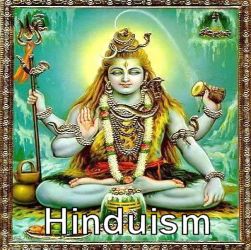|
Topics |
Vedas Upanishads
Other Primary Texts Epics Mahabharata
Ramayana Bhagavad
Gita Vedanta Later texts Also of
Interest The VedasThere are four Vedas, the Rig Veda, Sama Veda,
Yajur Veda and Atharva Veda. The Vedas are the primary texts of
Hinduism. They also had a vast influence on Buddhism, Jainism, and
Sikhism. The Rig Veda, the oldest of the four Vedas, was composed about
1500 B.C., and codified about 600 B.C. It is unknown when it was
finally comitted to writing, but this probably was at some point after
300 B.C. The
Vedas contain hymns, incantations, and rituals from ancient India.
Along with the Book of the Dead,
the Enuma Elish, the I Ching, and the Avesta, they are among the most ancient
religious texts still in existence. Besides their spiritual value, they
also give a unique view of everyday life in India four thousand years
ago. The Vedas are also the most ancient extensive texts in an
Indo-European language, and as such are invaluable in the study of
comparative linguistics.
SAMA
VEDA YAJUR
VEDA ATHARVA
VEDA
A Vedic Reader for Students by A.A. Macdonell
[1917] (excerpts) 121,143 bytes Upanishads
The Upanishads, Part I (SBE 1)
The Upanishads, Part II (SBE 15) Max Müller, translator [1879] (Sacred Books of
the East, vols. 1 and 15) Other
Primary Texts
The Laws of Manu George Bühler,
translator [1886] (Sacred Books of the East, vol. 25) The Epics
The
Mahabharata and Ramayana are the national epics of India. They are
probably the longest poems in any language. The Mahabharata, attributed
to the sage Vyasa, was written down from 540 to 300 B.C. The
Mahabharata tells the legends of the Bharatas, a Vedic Aryan group. The
Ramayana, attributed to the poet Valmiki, was written down during the
first century A.D., although it is based on oral traditions that go
back six or seven centuries earlier. The Ramayana is a moving love
story with moral and spiritual themes that has deep appeal in India to
this day. In
addition, a key Hindu sacred text, the Bhagavad Gita,
is embedded in Book Six of the Mahabharata. Mahabharata
The
Mahabharata now has its own page:
The Mahabharata,
translated by Kisari Mohan Ganguli [1883-1896] The
Ramayana
Rámáyan Of Válmíki translated by Ralph T.
H. Griffith [1870-1874]
The Ramayana in Sanskrit Abridged
Versions
Bhagavad GitaThe
Bhagavad Gita, usually considered part of the sixth book of the
Mahabharata (dating from about 400 or 300 B.C.), is a central text of
Hinduism, a philosphical dialog between the god Krishna and the warrior
Arjuna. This is one of the most popular and accessible of all Hindu
scriptures, required reading for anyone interested in Hinduism. The
Gita discusses selflessness, duty, devotion, and meditation,
integrating many different threads of Hindu philosophy.
The Bhagavadgîtâ with the Sanatsugâtîya
and the Anugîtâ translated by Kâshinâth Trimbak Telang, (Sacred Books
of the East, Vol. 8) [1882]
The Bhagavad Gita in Sanskrit The Bhagavad Gita
Vedanta The
Vedântâ-Sûtras, with commentary by Râmânuja, translated by
George Thibaut; (Sacred Books of the East, Volume 48) [1904] The
Vedântâ-Sûtras, with commentary by Sankarâkârya,
translated by George Thibaut; Part I (Sacred Books of the East, Volume
34) [1904]
The Crest-Jewel of Wisdom and other writings of
Śankarâchârya; translation and commentaries by Charles Johnston [1946,
copyright not renewed] Later
texts
The S'rimad Devî Bhâgawatam translated by Swami
Vijnanananda (Hari Prasanna Chatterji) [1921] The Devî Gita translated by Swami Vijnanananda (Hari
Prasanna Chatterji) [1921]
The Sánkhya Aphorisms of Kapila
Râmakrishna, His Life and Sayings Also
of interest...
How To Be A Yogi by Swâmi Abhedânanda
[1902] Indian
Folklore These
are western collections of Indian folklore, written in the 19th and
early 20th Century. Some of these texts are courtesy of Phillip Brown,
from his now-defunct Belinus.co.uk site (marked as [PB].
Twenty-two Goblins by Arthur W. Ryder
[1912] [PB]
The Indian Stories of F.W. Bain
|
|
